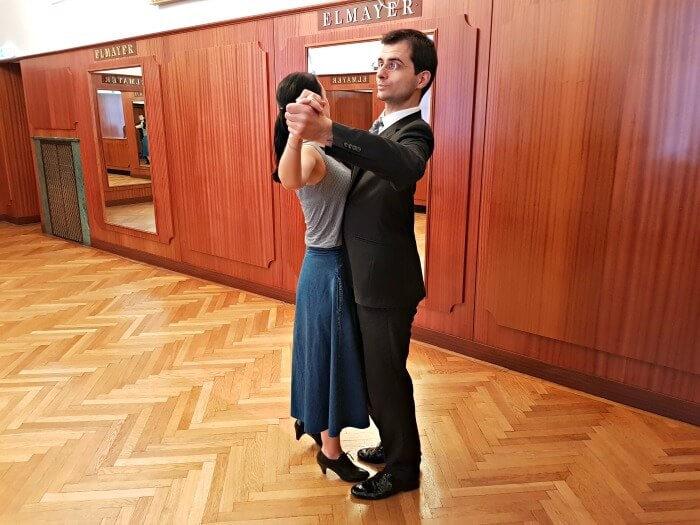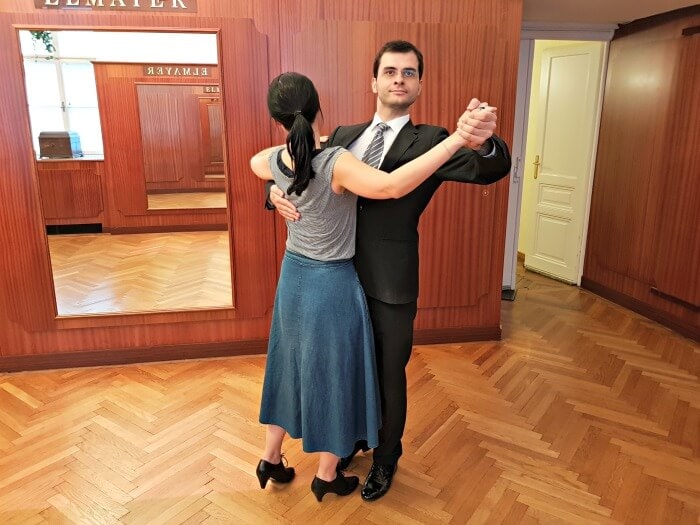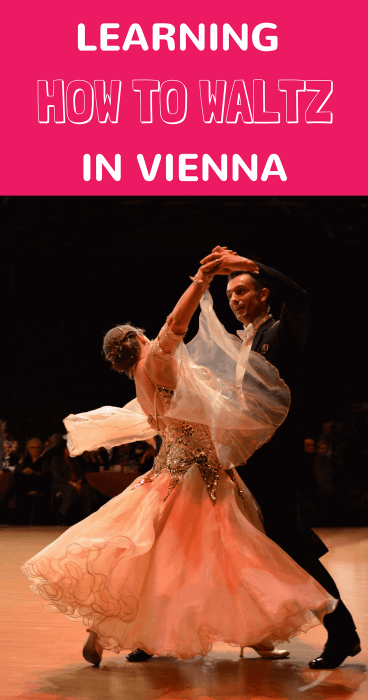In a little street in the busiest part of Vienna, Austria, a perfectly painted green door opens onto the world of ballroom dancing. It’s the entrance to a dance studio, and not just any dance studio.
Tanzschule Elmayer or Elmayer Dance School is an institution, a dance school where teenagers from all over Vienna come to take ballroom dance lessons in preparation for their first big ball. More experienced dancers go there to hone their skills and then there are the beginners, like me.
Below you can read about my experience learning to waltz in Vienna, as well as how you can do the same.
Learning how to waltz in Vienna
I walked in full excitement yet a little uneasy as well. Sure, I’ve been taking dance classes for 15 years already, but never Viennese waltz lessons and my hip-hop moves weren’t going to take me far here – or so I thought.
I introduced myself and said I was there for the 4 p.m. class – a group class specifically aimed at beginners and open to anyone visiting the city. You don’t need a reservation to join this class but you do need a dance partner. As I was solo in Vienna, they’d arrange a partner for me.
I went into the ladies dressing room to exchange my worn down sneakers for a pair of heels (with shoes attached to them, obviously). No need for proper ballroom shoes, they assured me. When I came back out, I could take a seat and wait for a bit.
After a few minutes, a gentleman entered the reception area. He turned out to be not only the dance teacher but my dance partner for the following hour as well. While we were supposed to be joined by another couple, they didn’t turn up and so my group class suddenly turned into a private waltz class.
At first, that was a bit scary but I soon realized that it’s a lot easier to learn Viennese Waltz – or any kind of dance, really, when you’re taking a private class and to my joy, I indeed learned quite a bit. In just one hour, we covered the basic steps of Viennese waltz, what the Viennese waltz steps diagram looks like and how to feel the Viennese waltz tempo.
We started with the most basic of all Viennese waltz dance steps: the Viennese Waltz carré or square. Left foot back, step to the right, right step forward. That wasn’t too hard!
Next, I needed to do it with him. Dance the carré, I mean. Right arm up, hand loosely in his, elbow pointing down and a little outward but never going further than the back. Right arm resting on his, right hand holding on to his arm. And off we were.
After the carré came two other basic Wiener waltz steps. A carré with a quarter turn to the right incorporated and then a carré with half a turn to the right incorporated. We practiced each of these combinations first solo, then dancing together, then to the music.
At the end of the class, after only one hour, I was whirling around the room! I couldn’t help but smile. This was what I love. Moving to the rhythm, focusing on the steps and enjoying it with every inch of my body.
I had learned how to dance the Viennese waltz! Well, kind of. I wasn’t going to call myself a Waltz dancer just yet :D
While we’d been practicing, we’d been dancing to English waltz music, which is slower than Viennese waltz music. English waltz dance music plays at around 30 bars (90 beats) per minute, while the Viennese waltz tempo is double that. That makes it one of the fastest ballroom dance styles out there.
So to finish the class, my dance instructor slightly upped the pace from 30 to 38, to 40 something, to 50 all the way up the speed of 60.
Damn, that was fast!
Somehow, there was a major difference between 55-something and 60 for me. At a little less than 60, I still felt in control of my movements while at 60, I felt more like I was being danced.
I struggled to keep the correct waltz posture and had to keep repeating the Viennese waltz rhythm to myself in my mind: “1-2-3, 4-5-6, waltz-waltz-waltz, waltz-waltz-waltz”.
After each round, I felt dizzy as well. And then my teacher taught me a trick that nobody has ever taught me in the 15 years that I’ve been dancing: when you’re dizzy from turning, all you need to do is turn in the opposite direction. And it worked!
Now, the reason I was dizzy was that I’d only learned the right waltz turn steps during my lesson. Once you advance with classes, you also learn the – harder – left turn and from then on you can alternate Waltz turns and play with it a bit to prevent yourself from getting dizzy.
And you know what? I might just take extra waltz lessons and learn how to do the waltz properly. I absolutely loved the experience and if I could learn to whirl around the room in one hour, the rest shouldn’t be too hard, right? RIGHT? ;-)
Want to learn to dance waltz too?
A bit of background on the Viennese Waltz
The Viennese waltz is a ballroom couple dance. Most people will relate it to long gowns, stately postures, and lots of turns. It’s the original waltz form, also known as the last waltz. Viennese waltz history is believed to go back to the 18th century, though its exact origin is unclear.
The Viennese waltz is danced at 60 bar or 90 beats per minute, much faster than the English or “slow waltz”.
Couples continuously turn to either the side of the follower or that of the leader, thus covering all sides of the room in a counterclockwise way.
Where to take Viennese waltz lessons in Vienna when you’re traveling there
If you want to learn to waltz in Vienna, I can highly recommend the Elmayer Dance School Vienna. There are probably other schools that offer waltz dance lessons for beginners in Vienna, but as this one came recommended by my friend Katrin of Visit Austria as the waltz institute in Vienna, I didn’t look further.
I got lucky that nobody else showed up for the group class I took (perhaps because I was a warm and sunny day?). I have no idea how many people attend the classes in general, but if you want to make fast progress or prefer getting private dance lessons, you can always contact the school to schedule one.
If you take the group class, the price was €45 per couple for one hour when I went. Prices may have changed since.
What to wear for your waltz class
Anything comfortable will do when you’re learning to dance waltz, but I can highly recommend ladies to wear a below-the-knee skirt and heels. You don’t need proper ballroom dance shoes but wearing heels will add to the experience and it will also allow you to learn how to take the Viennese waltz steps the correct way straight away.
It’s easier to learn the dance on heels immediately than to adapt from flat sole shoes to heels later on, as you’ll balance your weight differently on flat shoes than on heels.
Why the skirt? It’s not necessary, but it’s fun when you’re whirling around the room and your skirt is whirling with you :-) But the whirling is also the reason why you’re best to wear a below-the-knee skirt and not a mini skirt. You don’t want it to whirl up too much.
Skills needed
None, really. I asked and apparently, the Saturday waltz classes are classes where all beginners and visitors can learn how to waltz dance for beginners.
Call ahead?
Unless you have specific questions or need to get hooked up with a dance partner, it’s normally not necessary to call ahead or reserve your spot for these waltz classes, but COVID may have changed that.
In normal times, the 4 p.m. Saturday class is a drop-in class so you can just go to Elmayer 10 minutes or so before the class starts to register and change before you learn the waltz.
Where to stay in Vienna while taking waltz dance classes
I spent two nights at the Hotel Zeitgeist in Vienna. It’s a trendy hotel with a gym, sauna, large garden with playground and workout area and it also has restaurant where you can enjoy lunch, dinner or a drink at the bar.
Click here for the latest prices.
How to get to Vienna
If you’re coming from abroad, the easiest ways to travel to Vienna are by train and by plane. I took a direct flight from Brussels to Vienna Airport and then a train from the airport straight into the city center.
For a good overview of flight options and prices, check Skyscanner.
If you’re already relatively near Vienna or you simply prefer traveling by train, look here for timetables and prices.
PIN FOR LATER





Jade says
What a lovely experience! Learning an art from the country you’re visiting makes for lifetime memories. And you’re so fortunate you got a one-on-one lesson! #Win
Sofie says
I really got SO lucky! It’s an experience I’ll never forget :-)
Fred says
A very nice article, carefully and well written and informative.
You seem to have some experience in dancing. have you in any of your blog posts written anything about dance venues? I’ll read a bit more of your blog and see what I can find but I would be very grateful if you would use your obvious powers of observation on venues for dancing while travelling.
My wife and I have danced in odd corners of Mexican bars, in the foyer of “The dancing Man” pub in Southampton, on the banks of the Seine in Paris, dancing schools and cruise ships all over and at venues in our home town, but are always on the lookout for more.
Sofie says
Thank you!
Dance is a big part of my life but I’ve mostly kept it off this blog :)
So sorry, I’m afraid you won’t find any other dance venus on here.
Pam says
Why does not one photo of a waltz lesson have any sense of movement at all?
Sofie says
Because they’re posed photos from after the class. During the class… I was having the class :)